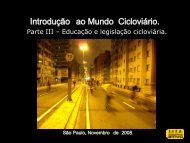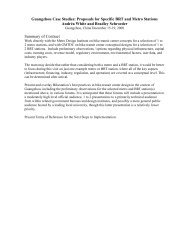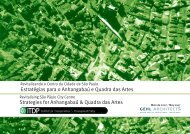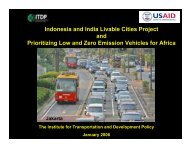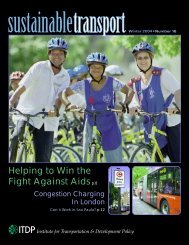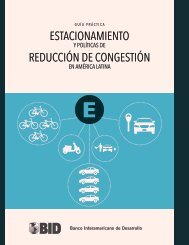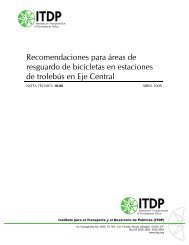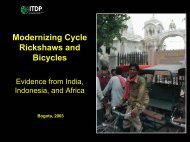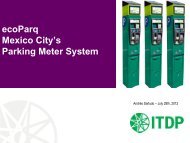Annual Report - ITDP | Institute for Transportation and Development ...
Annual Report - ITDP | Institute for Transportation and Development ...
Annual Report - ITDP | Institute for Transportation and Development ...
You also want an ePaper? Increase the reach of your titles
YUMPU automatically turns print PDFs into web optimized ePapers that Google loves.
ies. In India, the UN projects that cities will<br />
gain 167 million people by 2025 <strong>and</strong> absorb<br />
an additional 352 million residents by 2050.<br />
India’s urban expansion will require the<br />
construction of 700 million to 900 million<br />
square meters of residential <strong>and</strong> commercial<br />
space per year — equivalent to building two<br />
new Mumbais or another Chicago each year.<br />
It can seem overwhelming, but progress<br />
is being made. <strong>ITDP</strong> has been working in<br />
Ahmedabad, India, a city of six million, since<br />
2004. We were able to bring about India’s<br />
first world-class bus rapid transit (BRT)<br />
system in Ahmedabad in 2009, a result of<br />
years of work with the city. First, to convince<br />
them that a BRT was a smarter investment<br />
in transport than roads or expensive alternatives,<br />
<strong>and</strong> then to help guide city decisionmakers<br />
to ensure that the BRT system was<br />
top notch rather than just some minor<br />
modifications to the city’s chaotic buses.<br />
<strong>ITDP</strong> was also instrumental in pushing the<br />
city to build to new bike lanes <strong>and</strong> safer<br />
pedestrian spaces.<br />
Since these changes went into effect, several<br />
other Indian cities, including Chennai,<br />
Surat, Rajkot, <strong>and</strong> Pimpri-Chinchwad, have<br />
followed Ahmedabad’s lead <strong>and</strong> are now<br />
pursuing their own BRT, cycling, <strong>and</strong> pedestrian<br />
projects that promise to at least meet<br />
the bar set by Ahmedabad. <strong>ITDP</strong> remains<br />
actively involved in to help ensure that their<br />
projects deliver both social <strong>and</strong> environmental<br />
benefits to city residents <strong>and</strong> the planet.<br />
In China, we are experiencing the same<br />
positive momentum <strong>for</strong> change. Last year,<br />
after several years of <strong>ITDP</strong>’s advocacy <strong>and</strong><br />
technical work, Guangzhou opened an<br />
extraordinary BRT system, complete with<br />
bike lanes, bike share, <strong>and</strong> greenways along<br />
the route. Like Ahmedabad, Guangzhou is<br />
inspiring high quality replication in cities<br />
throughout the country. Cities like Lanzhou<br />
<strong>and</strong> Yichang that previously had not considered<br />
public transit or bike share are now<br />
taking up sustainable transport projects<br />
with fervor after witnessing the runaway<br />
success of Guangzhou. Fortunately, we’ve<br />
been able to be there at critical moments to<br />
shape these cities transport plans.<br />
Poor transport decisions <strong>and</strong> projects<br />
have long lifetimes. Once a highway is<br />
constructed or once a new car-dependent<br />
neighborhood is built, a city is <strong>for</strong>ever<br />
changed <strong>and</strong> the negative effects will haunt<br />
us <strong>for</strong> generations. <strong>ITDP</strong> continues to work<br />
tirelessly in cities around the world to help<br />
guide their development in ways that are<br />
sustainable <strong>and</strong> equitable.<br />
Thank you,<br />
Dr. Walter Hook, PhD<br />
Chief Executive Officer<br />
2011 <strong>Annual</strong> <strong>Report</strong> | 5



